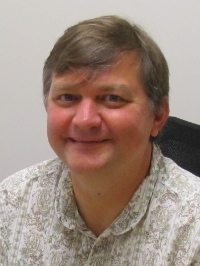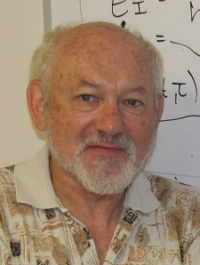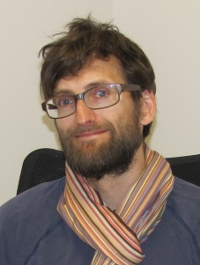Sabbatical Fellows at NIMBioS in 2013
NIMBioS supported several Sabbatical Fellows each year during the period 2010 – 2016. NIMBioS no longer provides financial support for Sabbatical Fellows, but continues to provide office space and a collaborative scientific environment for self-supported visitors. These individuals come to NIMBioS for visits of up to several months duration, with the length of stay determined by the objectives of the proposed project. For more information about self-supported visits and how to apply, click here.
Visitor/Sabbatical Archive

Kathleen Donohue (Biological Sciences, Duke University).
Project Title: How genetic pathways influence organismal responses to climate change: Linking genetic pathway models to demographic projections across a global range
The project will develop methods to predict life cycles, population performance, and geographic ranges of organisms under different climate scenarios. Building on an existing mathematical model of life-cycle expression, it will incorporate fitness and demographic consequences as well as models of genetic pathways that regulate specific life-cycle transitions. Analysis of this integrated model will identify pathways, environmental sensitivities, and environments that have the largest predicted effect on population performance, geographic range, and response to climate change, as well as investigate how specific genes and genetic pathway structure can influence these outcomes.
Sabbatical Dates: September - November 2013
Publications
Donohue, K, gibbs, DC. 2014. Gene duplication and the environmental regulation of physiology and development. Ecology and Evolution, 4(11): 2202-2216. [Online]
Herman JJ, Spencer HG, Donohue K, Sultan SE. 2014. How stable 'should' epigenetic modifications be? Insights from adaptive plasticity and bet hedging. Evolution, 68(3): 632-643. [Online]
Donahue K. 2013. Why ontogeny matters during adaptation: Developmental niche construction and pleiotorpy across the life cycle in Arabidopsis thaliana. Evolution, 68(1): 32-47. [Online]
Summary Report (pdf)

Jon Forde (Mathematics and Computer Science, Hobart and William Smith Colleges)
Project Title: Mathematical modeling of interacting populations in immunology and ecology
This project aims to develop a mathematical model of the dynamic interactions of populations in both immunological and ecological contexts, focusing on two systems: Celiac disease and the Mweru-Luapula fishery. Celiac disease is an autoimmune disease triggered by the ingestion of a protein found in wheat and other cereal grains. The research aims to model the interactions between the environmental trigger (gluten) and the immune response with the goal of providing an explanation for possible mechanisms that lead to tissue damage and disease. The Mweru-Luapula fishery provides the basis of a regional resource economy for roughly 250,000 people in Zambia and the Democratic Republic of Congo. Lack of elctive government regulation and open access to local fishermen make this a prime candidate for a "tragedy of the commons," yet the fishery appears to be stable. Using a harvesting model and incorporating local economic considerations, the research aims to understand the factors that might be preventing the "tragedy."
Sabbatical Dates: September 2013 - April 2014
Publications
Forde JE, Ciupe SM, Cintron-Arias A, Lenhart S. 2016. Optimal control of drug therapy in a hepatitis b model. Applied Sciences, 6(8): 219. [Online]
Presentations
NIMBioS seminar: Modeling the immune reaction to Hepatitis Delta infection. 10 September 2013.

Allan Strand (Grice Marine Laboratory, College of Charleston).
Project Title: Creating an Approximate Bayesian framework for estimating ecological processes from population genetic data
Approximate Bayesian computation (ABC) is a versatile estimation framework that provides an approximation of a posterior distribution when it is impossible to specify a likelihood model describing a natural process. This project will extend an existing simulation engine to take advantage of GPU technology and will explore the application of recent analytical advances that reduce
the number simulations required for ABC inference. Providing a framework for agent-based ABC opens up a novel avenue for estimating important ecological processes. As a case study, the project will focus on the dispersal of seeds in the coastal dune plant, Cakile edentula.
Sabbatical Dates: September - November 2013
Publications
Bell TM, Strand AE, Sotka EE. 2014. The adaptive cline at LDH (lactate dehydrogenase) in killifish Fundulus heteroclitus remains stationary after 40 years of warming estuaries. Journal of Heredity, 105(4): 566-571. [Online] [PDF]

Hong Qin (Biology, Spelman College)
Project Title: The impact of power-law configuration and error tolerant features of gene networks on cellular aging
Aging is a fundamental question in biology, yet its mechanism remains elusive despite decades of research. A model for cellular aging, yeast contains hundreds of genes known to influence lifespan, yet not a single gene can be claimed as a direct cause of aging. Yeast protein networks are known to be error-tolerant and have highly connected hub-genes that are less likely to directly interact with other hub genes. Also, an important source of robustness and heterogeneity in gene networks is the power-law configuration. Dr. Qin will focus on how power-law and error-tolerant features influence aging dynamics, hoping to gain new insights on cellular aging from the network perspective.
Sabbatical Dates: May - July 2013
Grants/Proposals
Qin H. 2015. CAREER: A probabilistic gene network model of cellular aging and its application on the conserved lifespan extension mechanisms of dietary restriction. NSF. $76,045. Accepted.
Summary Report (pdf)

David Gurarie
(Mathematics, Center for Global Health and Diseases, Case Western Reserve Univ.)
Project Title: Mathematical models of within-host parasite-immune dynamics with applications to malaria infection: data analysis and evolution of virulence
The malaria parasite has a complex life-cycle, and many details of the immune response to the parasite are not yet fully understood. The goal of this project is to develop mathematical models and efficient computer implementation of within-host dynamics for malaria-type parasites made of multiple strains and variants interacting with the adaptive host immunity, and apply these models to agent-based approach to community transmission and selection.
Sabbatical Dates: September 2012 - April 2013
![]() NIMBioS seminar: Agent-based approach to malaria: immunology, population genetics and evolution of virulence
NIMBioS seminar: Agent-based approach to malaria: immunology, population genetics and evolution of virulence
Presentations
Gurarie D, Ganusov V, Karl S, King CH. 2-6 November 2014. Population biology and immune selection for multi-strain malaria: Modeling approach. The American Society of Tropical Medicine and Hygiene 63rd Annual Meeting, New Orleans, LA. [Poster]
Gurarie D. September 2012. Heterogeneity in helminth infection, transmission and control (invited address). 13th International Symposium on Schistosomiasis, Belo Horizonte, MG, Brazil.
Disease transmission in complex environment: How mathematics could help to predict and control infections (colloquium). Medical School and Institute of Natural Sciences, UFMG (Federal University of Minas Gerais), Belo Horizonte, MG, Brazil.

Matthew Spencer
(Quantitative Biology, Univ. of Liverpool)
Project Title: From short-term dynamics to long-term consequences in species-rich communities
Some ecosystems have distinct and persistent community types under the same environmental conditions, such as in the human gut, savanna and forest states in sub-Saharan Africa, forest and grassland in temperate terrestrial habitats, and coral- or algal-dominated reefs. The goal of this project is to develop statistical techniques for understanding how these patterns arise from short-term dynamics in communities with large numbers of species.
Sabbatical Dates: September 2012 - January 2013
NIMBioS seminar: Measuring the rate of succession and the growth space of a community
Summary Report (pdf)
Publications
Spencer M. 2015. Size change, shape change, and the growth space of a community. Journal of Theoretical Biology, 369: 23-41. [Online]
NIMBioS
1122 Volunteer Blvd., Suite 106
University of Tennessee
Knoxville,
TN 37996-3410
PH: (865) 974-9334
FAX: (865) 974-9461
Contact NIMBioS


